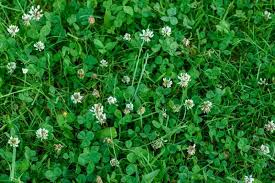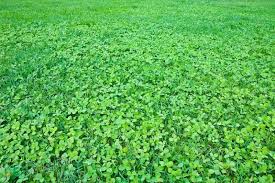Clover may appear innocent enough, but it can easily take over your beautiful green lawn. If you are considering how to get rid of clover in grass without hurting your lawn, it will involve consistent care alongside the right natural treatments. Whether you are trying to eliminate clover from grass or just maintain a healthy lawn that is even, knowing what causes clover growth can help you control and limit its future growth
How to identify clover
Clover often goes unnoticed in your lawn until it begins to develop soft, bright-green patches that are not quite like the grass. Knowing how to identify clover early will give you better chances to have a lush, uniform yard and to prevent it from spreading. It is necessary lawn maintenance to get get rid of clover in lawn.
Leaf Shape and Pattern
Clover can easily be recognized due to its iconic three-leaf configuration. Each leaf is tiny, rounded, and usually demonstrates a pale white “V” stretched across its center. A four-leaf clover can be occasionally spotted, but the majority have three leaves.
Growth Habit
Clover grows low to the ground and creates thick mats that take up space where weak grass would normally grow. The creeping stems allow it to quickly spread across thin or bare areas of the lawn, and this is why it is commonly found in these areas of poor or compacted soils.
Flowers and Color
In the spring and throughout summer, clover gets small creamy white or somewhat pink flowers which attract bees. The leaves are softer and a more vibrant shade of green than most grasses, so you can easily notice them when sunlight hits the lawn.
Where It Thrives
Clover grows well in lawns that are lower in nitrogen. By properly fertilizing, you can strengthen your grass and reduce clover competition. Once you routinely check your lawn, you can track clover and decide how to address clover organically before it turns into a larger issue.
How to get rid of clover
Clover may seem innocent, but once it has spread across the lawn it can crowd out healthy grass and give your yard a patchy look. Fortunately, eliminating clover from grass won’t injure your yard – you simply need to cultivate the right level of care, patience and consistency.
Understand Why Clover Grows
Clover commonly emerges when soil is deficient in nitrogen or the grass is thin. Instead of attacking clover plants immediately, start by enriching the soil. A slow-release nitrogen fertilizer cultivates the grass, which will then compete against clover and other weeds.
Manual Removal for Small Patches
If you only see a small amount of clover, you may simply pull the clover out by hand. If needed, use a small weeding tool to pull out the clover roots. Once the clover is removed, water the soil and reseed small areas with grass to avoid the clover from returning.
Encourage Healthy Lawn Growth
A thick, healthy lawn is the best defense to avoiding clover.
- Mow your lawn slightly higher (approximately 3-4 inches), so it shades out clover.
- Water your lawn deeply and less frequently to allow for more developed roots.
- Occasionally aerate your lawn (once a year is a good recommendation), to improve soil health and reduce compaction.
Natural Treatments That Work
If you are looking for something that you can spray on the clover in your lawn safe, mix a solution of white vinegar, dish soap and water and spray directly on the clover leaves. Apply this on sunny days for best results – the solution works by essentially drying the weed out and is safe for most grasses.
Long-Term Prevention
To keep the grass healthy enough to fend off future clover growth, continue with regular mowing, watering, and feeding. If you’re looking for something herbicide safe you can spray on the clover in your lawn, make a solution of white vinegar, dish soap, and water, then spray on the leaves of the clover plant. Apply the solution during a sunny day for the best result, as this works by effectively drying out the weed, and is safe for most grasses. If you would prefer a more hands-off style of dealing with weeds, you can hire an organic lawn care company to professionally track and treat weed growth while continuing to protect the grass from damage.
If you are willing to remain consistent and focus on soil health rather than toxic chemicals, you can naturally get rid of clover and enjoy a greener, thicker, and healthier lawn through the fall and winter.
How to prevent clover in your lawn
The first step in stopping clover from overtaking your lawn is understanding why it shows up in the first place. Clover prefers to grow in poor soil conditions or where the grass is weak. If you can improve your lawn’s condition and perform regular upkeep, you can stay ahead of clover before it becomes an issue.
Strengthen the Soil
Healthy soil discourages clover growth.
- In the spring and fall apply a slow-release nitrogen fertilizer to ensure that your grass stays strong and healthy.
- Test your soil once a year for soil pH (ideally 6.0-7.0).
- Use organic compost or lawn food to replace nutrients that support the gradual growth of grass.
Mow at the Right Height
Clover thrives in short, closely cut lawns. Increase the height of your mower (about 3–4 inches) so the taller grass blocks the sun from reaching the clover seedlings in the soil. Making this simple adjustment will reduce weed growth over time.
Water Deeply, Not Often
Light watering promotes shallow roots, which clover loves. Instead, water your lawn a good soak only once or twice a week for deep strong grass roots. Strong grass naturally outcompetes weeds like clover.
Reseed Bare or Thin Areas
Bare spots are an invitation for clover to encroach. Reseed thin areas in the early spring or the fall. You want to keep your lawn thick and lush! A thick lawn provides trained weeds with no space for growth.
Maintain Regular Lawn Care
Routine maintenance is the best way to minimize clover in grass before it does appear. Consistent fertilizing, mowing, and watering will make your lawn a place where clover simply won’t survive!
By focusing on prevention instead of constant removal, you’ll spend less time fighting weeds and more time enjoying a green, healthy, and clover-free lawn that stays strong through every season.
Conclusion
Eliminate clover from grass takes ongoing effort and good management of the lawn. You can begin by improving soil quality and maintaining a dense and well-fed turf; healthy grass will push out weeds on its own. Consistent mowing, deep watering, and appropriate fertilization work to keep clover from returning, even in tough areas. If you find a few patches that are more difficult to control, there are select herbicides available to kill clover without impacting any grass, or create a manual and get outside and pull the weeds out if you have a smaller area! Over time, these steps will help you to manage and eliminate clover from the grass and keep your lawn lush, green, and uniform throughout the growing season!
FAQs – How to Get Rid of Clover in Lawn
- Why does clover grow in my lawn?
Clover typically develops in soils low in nitrogen or when the growth of grass is limited. If your lawn is underfed, you’ll see clover thrive in the home lawn. Improving lawn care and fertilization will reduce clover naturally over time. - What kills clover but not grass?
Use selective, broadleaf herbicides that will eliminate clover without harming grass. Always read the label and apply when grass and weeds are in active growth. - How can I get rid of clover naturally?
To naturally remove clover from grass, you can apply organic fertilizers made of nitrogen, cut grass regularly, and create a healthy dense lawn. Hand-pulling small areas can help. - Will clover come back after removal?
If your soil conditions are still poor, it may. If you want to prevent clover from coming back, ensure your lawn is nourished regularly, aerate the soil every year, and don’t cut too short. - Is clover harmful to my lawn?
Not really—clover inputs nitrogen into the soil. However, if you prefer a uniform look and only grass, proper lawn care with selective herbicides will get rid of clover in lawns effectively






